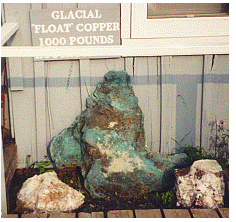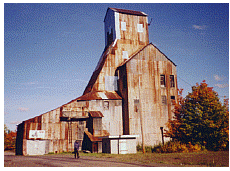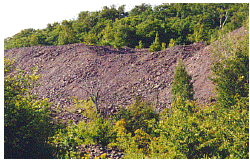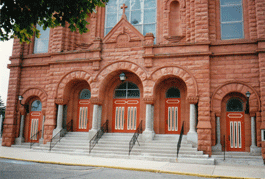
Rock Collecting Tour of the Western Upper Peninsula of Michigan - "The Copper Country"You are now heading for the Upper Peninsula of Michigan's world famous "Copper Country", the Keweenaw Peninsula. In this part of the Upper Peninsula, you are in the heart of the best rock collecting ground in the North Central States. (Map)
Thanks to Benjamin Franklin, the Keweenaw Peninsula and Isle Royale are part of the United States. Franklin was a member of the commission that drew up the boundaries for the Treaty of Paris in 1773, ending the Revolutionary War. Ben Franklin had heard of the rich mineral deposits in the Keweenaw and Isle Royale so he drew the boundary line to the north of Isle Royale, giving this area to the United States Upper Peninsula copper occurred in the only type of deposit which could have been of much value in a day of primitive metallurgy. The red metal found on Lake Superior came out of the ground so free of adulterants that it could be formed into pots and pans without refining or processing. From 1843 to the 1920's, the Upper Peninsula was the only place on earth where pure, workable native copper was found in commercial quantities. The term "native" as used by mining men is synonymous with "pure", "virgin," or "unadulterated." Not until the 1920's when a similar deposit was developed in Coro Coro, Bolivia, were mining men able to locate a commercially important deposit of native copper anywhere else in the world. The mine dumps throughtout the Keweenaw from Ontonagon north to Copper Harbor may contain some or all of the following: Ankerite; Calcite, some with native copper inclusions; Chlorastrolite (aka Greenstone); Chrysocolla; Native Copper ; the rare Datolite, some with native copper inclusions, pastel colors, nodules to 7" in diameter, outer appearance that of a dark cauliflower; Domeykite; Epidote; Laumanite; Prehnite; Quartz; native Silver wires, Tenorite and Wollastonite. Before starting out to make your Copper Country collection you should visit the Seaman Mineral Museum at the Michigan Technological University 1404 E. Sharon Avenue, Houghton, MI. The museum has a new building with a parking lot outside. Their collection has recently been expanded by the addition of the mineral collection from the University of Michig an as well as the world's finest display of minerals from the Lake Superior Copper District. There you can see samples of the minerals you are going to look for and your search of the rock piles will be much more interesting. Phone 906-487-2572.
Follow Highway 26 north for your next expedition to the Baltic No. 2 mine near the village of South Range, about seven miles south of Houghton. First you should look for specimens of native, or free copper. At the Baltic mine also look for chalcocite, a sort of bluish-black mineral, about the color of a gun barrel. It is in narrow veins in rock. If you find a mineral coated with "peacock colors" it is probably bornite. Bornite is the color of bronze when fresh but on exposure to the air tarnishes to shades of purple and red. If you find a mineral which looks much like brass, it is chalcopyrite. These three minerals all contain copper and are the types of ore mined in some western copper mining districts which do not have the free copper of the Keweenaw Peninsula. Approaching Houghton, inquire at the village of Atlantic on Highway 26 for the Isle Royale series of shafts and the old Huron mine. Several minerals can be found on the old rock piles of these mines. You should have no trouble in picking up attractive specimens of rock crystal quartz, the crystals being one half inch or more in length and projecting into the central part of the geodes crystal-lined cavity. At the Huron mine, in addition to quartz, a soft pink mineral known as laumontite may be found. Chlorite, a dark green mineral forming small shot like pebbles imbedded in lava, is one of the easiest minerals to recognize on the Isle Royale rock piles. You should look for calcite, a white mineral which breaks or cleaves into rhombs, and you may find some geodes with calcite crystals. If you find a chunk of rock cut through by a vein of light greenish mineral which has the glassy or vitreous look of quartz, the mineral is prehnite. Where prehnite was formed in openings in the rock, much of the surface is a mass of small, rounded knobs with slender crystals radiating into the knobs.
At the Arcadian Mine dump, you should find Ankerite; Calcite, some with native copper inclusions; Chlorastrolite; Chrysocolla; Copper, native; Domeykite; Epidote; Laumanite; Prehnite; native Silver, and Tenorite. At the Quincy Mine dump on the north side of Hancock, you will see Ankerite; Calcite: some with native copper inclusions; Chlorastrolite; Chrysocolla; Copper, native. At the Iroquois Mine north of the Houghton-Hancock area some very fine Datolite can be found. Now start your tour northward into the heart of the Keweenaw Peninsula. (Food and Lodging) Take Highway 41 north to Calumet, go west on SR 203 to McNair State Park. Collect along the shoreline northeast to the Keweenaw County border. Look for Adularia; Agate, fortification (Lake Superior); Chalcedony; Chert; Jasper and Thomsonite. The next stop is about twenty miles from Houghton at the Wolverine mine, near the town of Kearsarge. Mohawk could be your base for collecting at Kearsarge, Mohawk, Allouez, Ahmeek, Phoenix, Central and Copper Falls Mines. The town of Mohawk, built alongside the 6 shafts of the Mohawk Mines, was the metropolis of the Keweenaw Peninsula during the mining years. The Mohawk mine had at least one shaft that produced the rare Mohawkite, a compound of copper, arsenic, nickel and cobalt. Mohawkite is gray when broken but changes to purple or yellow when it tarnishes. At Kearsarge (Wolverine Mine) you can find attractive specimens of red microcline feldspar filling cavities in the lava rock. Within the microcline is a filling of white calcite, so you should have no trouble spotting this mineral. In the waste rock of the Wolverine mine you can find geodes or cavities lined with green crystals of epidote. If you should find a bluish green mineral which looks like turquoise, it is chrysocolla, another copper-bearing mineral. Other copper minerals are cuprite, which is a sort of brick red color, and tenorite, which is black. From the Wolverine mine it is not far to the Mohawk, Seneca, and Ahmeek No. 2 mines. This area is a paradise for collectors. Domeykite or algodonite are two very similar minerals containing copper and arsenic. Just north of Kearsarge are the mining towns of Allouez and Ahmeek area. At the Ahmeek Mine, you should find Algodonite, Domeykite, and Massive Quartz. At the Allouez Mine, look for Chrysocolla. In the Allouez area, take Fivemile Point Road to rough road going southwest; follow this to the Gratiot River beach where you may find Agate, banded; Agate, bull's-eye; Agate, fortification (Lake Superior); Jaspillite; Specularite and Thomsonite, pink and green. Also in the Allouez area, take Fivemile Point Road to turn-off marked with sign for Pete's Beach; then drive through the woods to the shore. Look for Agate, fortification (Lake Superior) and Thomsonite, pink and green.
You will see roadside stands with pieces of the real native copper for sale. Stop and take a look. Some of the local people know where to look for large pieces of copper, but they do not share their information. A large piece of copper could make a stunning contribution to your collection. One of the nicest displays is in Mohawk at In the Mohawk area at the Central Mine dump look for Ankerite; Calcite, some with native copper inclusions; Chlorastrolite; Chrysocolla; Copper, native; Domeykite; Epidote; Laumanite; Prehnite; Silver, native and Tenorite. At the Cliff Mine dump in the Mohawk area you will find Ankerite; Calcite, some with native copper inclusions; Chlorastrolite; Chrysocolla; Copper, native; Domeykite; Epidote; Laumanite; Prehnite; Silver, native, dendritic wires; Tenorite; Wollastonite, pale flesh red. At the Delaware Mine dump search for Ankerite; Calcite, some with native copper inclusions; Chlorastrolite; Chrysocolla; Copper, native; Domeykite; Epidote; Laumanite; Prehnite; native Silver and Tenorite. At the Mohawk Mine, you should find Algodonite; Copper, native, free-form dendritic swirls; Domeykite; Massive Quartz At the Phoenix Mine dump near Mohawk there will be Ankerite; Calcite, some with native copper inclusions; Chlorastrolite; Chrysocolla; Copper, native; Domeykite; Epidote; Laumanite; Prehnite; Silver, native, wires; and Tenorite. In the Mohawk area at the Star Mine dump, watch for Ankerite; Calcite, some with native copper inclusions; Chlorastrolite; Chrysocolla; Copper, native; Domeykite; Epidote; Laumanite; Prehnite; Silver, native, wires; and Tenorite. Another stop for mineral collections is at the Copper Falls mine where datolite has sometimes been found. It forms rather complex crystals of various colors, white, pink, yellow, brown and greenish. You should also look for cavities in the lava which are lined with small reddish crystals of analcite. Long slender needle-like crystals of natrolite are sometimes found with the analcite. A few additional minerals are common enough to be of interest to the collector. These are ankerite, anhydrite, gypsum, barite, augite, iddingsite, thomsonite, malachite, whitneyite, apophyllite, and adularia. Several rare minerals are in the dikes and veins of the crystalline rocks. Sheelite and Wolframite, the ores of the strategic metal tungsten, are found in many places, but no large commercial deposits have been located. Take 41 on north to Copper
Harbor. While in the Copper Harbor area, go west on trail road to Esrey Park. Collect on shore and in the ledges at the back of the park. Agate, banded; Agate, bull's-eye; Agate, fortification (Lake Superior); Chalcedony; Chert; Jasper; Jaspillite; Specularite; Thomsonite, pink, green. At the Mandan Mine dump, just south of Copper Harbor, collect Ankerite; Calcite, some with native copper inclusions; Chlorastrolite; Chrysocolla; Copper, native; Domeykite; Epidote; Laumanite; Prehnite; Quartz, rock; Silver, native; Tenorite and Wollastonite. Take highway 26 out of Copper Harbor on your way back to Houghton. In the Eagle River area, collect northeast along the beaches all the way to Eagle Harbor. Look for Adularia; Agate, banded; Agate, bull's-eye; Agate, fortification (Lake Superior); Chalcedony; Chert; Chrysocolla; Jasper; Jaspillite; Specularite and Thomsonite. If you walk along the Lake Superior beach, you can walk the shores to the high tide mark or hard sand. You don't have to be in the water. Submerged bottomlands of the Great Lakes are open to the public.
In Calumet, look at St. Paul the Apostle Church and the Upper Peninsula Firefighters Museum for buildings constructed of this stone. Once you have seen the buildings, you will recognize the redstone wherever you see it.
Much of this information is from Rocks and Minerals of
Michigan By O. F. Poindexter, H. M. Martin and S. G.
Bergquist, Michigan Department of Natural Resources, 1971
and Rock Collectors may enjoy: Copper Country Road Trips: Enjoy Keweenaw History From The Comfort Of Your Car, by Lawrence J. Molloy. Guide book for tours of mining locations, sites and ruins. Find the hidden mines and rockpiles. Includes maps, pictures, historical information and precise directions. Published and printed by Great Lakes GeoScience, Hubbell, Michigan. Available for purchase at Gitche Gumee Landing in Ontonagon or by mail order. Phone: 906-884-6618
Rock Collecting Tour of the Eastern and Central Upper Peninsula
Back to the Upper
Peninsula Recreation page |
 On Highway 26 south of Houghton you can stop at the
Painesdale Mine to see the
On Highway 26 south of Houghton you can stop at the
Painesdale Mine to see the 

 Then
head for the Clark mine where you should be able to find
Ankerite; Calcite, some with native copper inclusions;
Chlorastrolite; Chrysocolla; Copper, native; Domeykite;
Epidote; Laumanite; Prehnite; Silver, native and Tenorite.
Then
head for the Clark mine where you should be able to find
Ankerite; Calcite, some with native copper inclusions;
Chlorastrolite; Chrysocolla; Copper, native; Domeykite;
Epidote; Laumanite; Prehnite; Silver, native and Tenorite.
